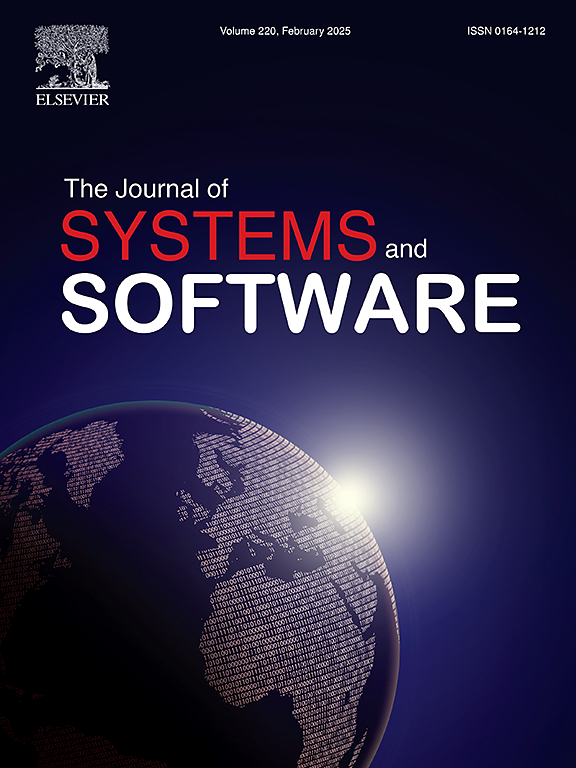Integrating neural mutation into mutation-based fault localization: A hybrid approach
IF 3.7
2区 计算机科学
Q1 COMPUTER SCIENCE, SOFTWARE ENGINEERING
引用次数: 0
Abstract
Fault localization is an important part of software testing and debugging, helping improve the process of fixing faults. Mutation-Based Fault Localization (MBFL) is widely used, but the reliance of Traditional-MBFL on syntactical mutants often limits its accuracy. To address this, we propose Neural-MBFL, which introduces neural mutation to generate semantically richer mutants using deep learning to better mimic real faults. Additionally, we present NeuraIntegra-MBFL, which combines neural and traditional mutation strategies through mutant combination and suspiciousness aggregation. Experiments on 835 faulty programs from the Defects4J benchmark show that Neural-MBFL improves fault localization compared to Traditional-MBFL, with a 35.50% relative improvement in MAP and 127 more faults localized at TOP-5, while maintaining acceptable computational cost. Compared to Neural-MBFL, NeuraIntegra-MBFL further enhances performance, particularly with suspiciousness aggregation, achieving an additional 11.96% MAP improvement and localizes 45 more faults at TOP-5, demonstrating the effectiveness of integrating suspiciousness scores. Using overlap and correlation analyses, we confirmed the complementarity between Neural-MBFL and Traditional-MBFL. Neural-MBFL is more effective at localizing faults that require understanding deep code semantics, while Traditional-MBFL performs better at handling rule-based modifications. NeuraIntegra-MBFL successfully integrates the strengths of both methods, offering better performance than either approach alone.
将神经突变融入基于突变的故障定位:一种混合方法
故障定位是软件测试和调试的重要组成部分,有助于改进故障修复过程。基于突变的故障定位(MBFL)被广泛使用,但传统 MBFL 对语法突变的依赖往往限制了其准确性。为了解决这个问题,我们提出了神经突变 MBFL,它引入神经突变,利用深度学习生成语义更丰富的突变体,从而更好地模拟真实故障。此外,我们还提出了 NeuraIntegra-MBFL,它通过突变体组合和可疑度聚合将神经突变策略与传统突变策略相结合。在 Defects4J 基准的 835 个故障程序上进行的实验表明,与传统 MBFL 相比,Neural-MBFL 提高了故障定位能力,MAP 相对提高了 35.50%,TOP-5 级定位的故障增加了 127 个,同时保持了可接受的计算成本。与神经-MBFL 相比,NeuraIntegra-MBFL 进一步提高了性能,特别是在可疑度聚合方面,MAP 提高了 11.96%,在 TOP-5 级定位的故障增加了 45 个,这证明了可疑度分数整合的有效性。通过重叠和相关分析,我们证实了神经-MBFL 和传统-MBFL 之间的互补性。神经-MBFL 在定位需要理解深层代码语义的故障方面更有效,而传统-MBFL 在处理基于规则的修改方面表现更好。NeuraIntegra-MBFL 成功地整合了这两种方法的优势,其性能比单独使用其中一种方法更好。
本文章由计算机程序翻译,如有差异,请以英文原文为准。
求助全文
约1分钟内获得全文
求助全文
来源期刊

Journal of Systems and Software
工程技术-计算机:理论方法
CiteScore
8.60
自引率
5.70%
发文量
193
审稿时长
16 weeks
期刊介绍:
The Journal of Systems and Software publishes papers covering all aspects of software engineering and related hardware-software-systems issues. All articles should include a validation of the idea presented, e.g. through case studies, experiments, or systematic comparisons with other approaches already in practice. Topics of interest include, but are not limited to:
•Methods and tools for, and empirical studies on, software requirements, design, architecture, verification and validation, maintenance and evolution
•Agile, model-driven, service-oriented, open source and global software development
•Approaches for mobile, multiprocessing, real-time, distributed, cloud-based, dependable and virtualized systems
•Human factors and management concerns of software development
•Data management and big data issues of software systems
•Metrics and evaluation, data mining of software development resources
•Business and economic aspects of software development processes
The journal welcomes state-of-the-art surveys and reports of practical experience for all of these topics.
 求助内容:
求助内容: 应助结果提醒方式:
应助结果提醒方式:


